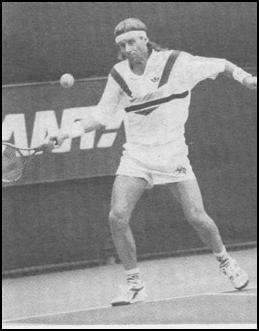Revolutionary Tennis |
||
Tennis Instruction That Makes Sense |
||
Head-On
THE FOREHAND: OPEN STANCE AND HIP ROTATION Two TENNIS magazine articles here explaining how to better hit a high forehand and sitter. The establishment teaches as the basic form an open stance forehand and body rotation, and all teaching articles build from those beliefs. Let's see if we are seeing what they are saying. First a small excerpt from TENNIS magazine's March, 2004 issue: HARD TO HANDLE: HIGH FOREHANDS, HITTING HIGH FOREHANDS CAN BE A TALL ORDER. HERE ARE FIVE ADJUSTMENTS THAT WILL HELP, by Curly Davis. Only one of the five adjustments addresses the body's structure and footwork. [Photos by Chris Trotman/Getty Images.] #2. Employ an open stance "An open stance allows the non-racquet side of the body to clear out during the swing for an unrestricted finish. Your hips and lower body can also easily rotate into the shot, giving it more power. This added arm freedom will help you handle a shot at your shoulders. To get into an open stance, line up the ball with your back foot so that it, and not your lead foot, is closer to the point of contact. Load your weight onto the back leg so you can fire your back hip into the shot." End quote.
It is preferable to remain in an open stance while addressing the high forehand for reasons of rhythm, vision, and timing. But during the girl's forward swing the photos show she does not remain in an open stance. She hits the ball off the front foot. What is an open stance? An open stance finds the back foot closest to the ball during the pre-contact phase, yes, and the front foot a little further out into the court. From this position you can shift your body's weight either by A) rotating on your back leg, B) rotating on the front leg, or C) moving your front foot forward. A) is a true open stance, that is the body's weight remains on the back leg during the forward swing, body weight can only be shifted via rotation like a golfer and the front leg lifts but does not move forward, at times it winds up going backwards. With B) the front leg acts as a pivot foot, it remains planted and you spin on it so the back leg lifts and comes around and forward. Rotation again. C) is contact off the front foot, no longer an open stance. In the old days you were told to stand sideways, literally, and take crab-like steps to the ball (but has anything really changed?). The back foot would drag behind you, it was never the closest foot to the ball, the front foot was. The idea of placing the back foot closest to the ball prior to the forward swing is a good idea instead of dragging it behind you, this speaks to the bipedal footwork pattern seen in Step 2 and applies to all strokes except the serve. From this allegedly "open" position, though, you can take a step forward into the ball with the front foot and thus be hitting off the front foot. And this is exactly what the photos show in both articles though the writers don't mention it.
In the first photo the girl is in an open stance but her front foot winds up going forward in the photos that follow. She is timing the ball by taking a step forward with the front foot instead of rotating in-place on either foot. Furthermore, linear momentum here is the grandfather of her power structure and not rotation. Yes there's angular momentum, but Revolutionary Tennis says linear momentum not only comes first but is the well-house of the body's power delivery system instead of angular momentum, which is stroke related. In the old days this player would have remained in an open stance while hitting this high forehand or not have left the ground while stepping into the ball with the front foot. Certainly this girl is loading her weight on her back leg, duh!, and she could remain in an open stance during contact but she chooses not to as the ensuing photos clearly show. She steps forward into the ball and times it off the front foot - her front leg is not lifting and moving back during contact, her back leg is not swinging around during contact, both of which would mean and show an open stance contact. At the end here I will show a photo of Borg's open stance and a sequence by Navratilova for further clarification. The second article by Juan Nuņez, May 2004, gives excellent advice on how to put away a sitter [photos by Fred Mullane/Camerawork, USA], and though he talks about footwork his photos show a larger picture of footwork left undiscussed. It reads:
His first photo illustrates how you step forward with the back foot prior to contact and allow the back leg to push your body [forward] toward the ball. All is well and good but again, the second photo shows this is front foot contact and not open stance contact. Juan's back leg pushes him forward toward the ball and he hits off the front foot, not the back foot. It's front-foot contact and NOT AN OPEN STANCE as may be implied or inferred. This is our (a hitter's) preferred method of timing and power, off the front foot. If the front foot doesn't touch down on the court prior to contact in a more traditional sense that's okay, as long as it was on its way, which is similar to volleys where often you hit the ball before your front foot steps, or touches down, on the court. Lost in both these examples is the larger picture of what footwork is. Each player takes a step with the back foot and then another with the front foot during the striking routine. This is the 1-2 pattern that defines human footwork for any endeavor as revolutionary tennis outlines in Step 2.
Everywhere, on tennis courts and in magazines, and at every level, this kind of evidence regarding footwork, rhythm, and movement direction for success can be seen. This success has nothing to do with a unit-turn, open stance, rotation. As repeated throughout Revolutionary Tennis, sadly these details which help flesh out the larger picture are overlooked which in turn would make it easier for you to play the game. While Lleyton Hewitt will turn his back foot out to the side as an initial reaction, watch what he does once he goes after the ball. His initial move is no different than an outfielder taking a couple of steps back and over before moving forward to the ball once he gets his bearings straight. Are baseball outfielders instructed to move back first? Of course not, but they have time and real estate tennis players don't. I include a photo sequence of Martina Navratilova hitting a forehand return from World Tennis magazine. Exactly as opined above in TENNIS magazine, her back foot steps forward and closer to the ball than the front, and exactly as the other photos she launches forward and times the ball off the front foot. Ask her if this is an open stance situation or front foot contact. Anyone out there know her? Ask her.
This photo of Borg shows an open stance. He is loading his weight on his back leg, yes, but when he hit the ball his back foot remained back where it is now for the most part. At times he would do an open Forward Stance, that is taking a tiny step into the ball with the front foot, but mostly he would remain in place and rotate around.
|
||
|
|
||||||||||||||||||||||||||||||||||||||||||||||||||||||||||||||
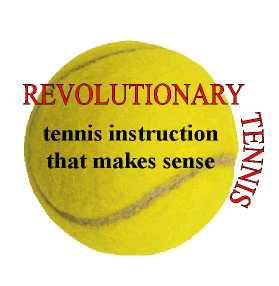
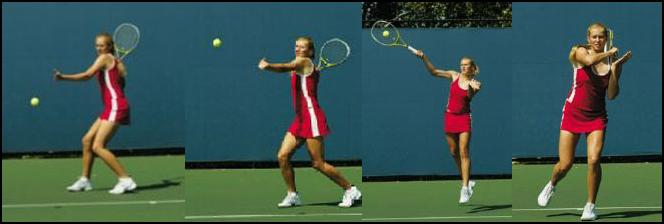
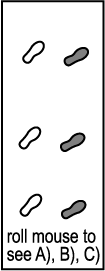
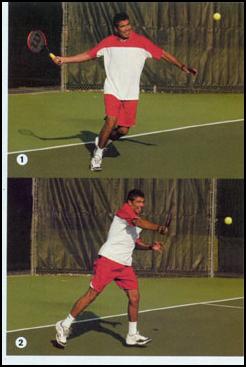 "When you move up to a short ball and you're the right distance from it (1) step forward with your right leg (left if you're a lefty). Make sure you slightly pivot, or turn, your planting foot so that your toes point out. This facilitates your upper-body rotation on the backswing while you load your weight onto your planting leg. Keep your racquet on the side of your body at shoulder level with the head above your cocked hitting wrist. You want to strike the ball at the same level of your take-back; at the same time, your planting leg should be pushing your body toward the ball. Use your wrist to accelerate the racquet and (2) drive the ball toward your target for a winner." End quote.
"When you move up to a short ball and you're the right distance from it (1) step forward with your right leg (left if you're a lefty). Make sure you slightly pivot, or turn, your planting foot so that your toes point out. This facilitates your upper-body rotation on the backswing while you load your weight onto your planting leg. Keep your racquet on the side of your body at shoulder level with the head above your cocked hitting wrist. You want to strike the ball at the same level of your take-back; at the same time, your planting leg should be pushing your body toward the ball. Use your wrist to accelerate the racquet and (2) drive the ball toward your target for a winner." End quote.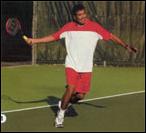 The 1, or the back foot in the picture, has its toes turned in (as predicted by
The 1, or the back foot in the picture, has its toes turned in (as predicted by 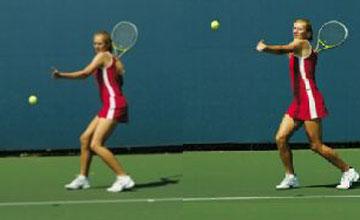 Without further advising that stepping forward with the back foot is part of a 1-and-then-2 footwork plan all of which falls under the umbrella of how to move forward in footwork rhythm, students everywhere will think the above advice is all about the counterproductive ideas of hitting off the back foot and rotating the (back) hip(s). While these two players' hips do rotate (our hips rotate even when walking in a straight line), the two players are launching themselves at and into the ball in a straight line. The stroke is angular and causes rotation, yes, but these players make their lower bodies go straight at and into the ball before this angularity from the stroke kicks in. Without their lower body's input from linear momentum the upper body's "rotation" would be worthless. Just try standing still and rotating your upper body for some "power."
Without further advising that stepping forward with the back foot is part of a 1-and-then-2 footwork plan all of which falls under the umbrella of how to move forward in footwork rhythm, students everywhere will think the above advice is all about the counterproductive ideas of hitting off the back foot and rotating the (back) hip(s). While these two players' hips do rotate (our hips rotate even when walking in a straight line), the two players are launching themselves at and into the ball in a straight line. The stroke is angular and causes rotation, yes, but these players make their lower bodies go straight at and into the ball before this angularity from the stroke kicks in. Without their lower body's input from linear momentum the upper body's "rotation" would be worthless. Just try standing still and rotating your upper body for some "power."
